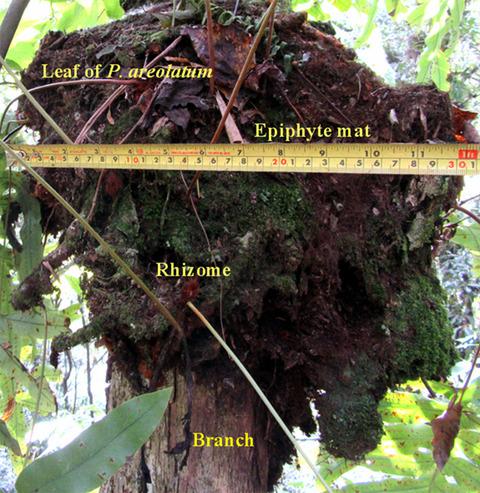当前位置:
X-MOL 学术
›
Plant Biol.
›
论文详情
Our official English website, www.x-mol.net, welcomes your feedback! (Note: you will need to create a separate account there.)
Epiphyte associations and canopy soil volume: nutrient capital and factors influencing soil retention in the canopy.
Plant Biology ( IF 3.9 ) Pub Date : 2020-01-16 , DOI: 10.1111/plb.13080 E Victoriano-Romero 1 , J G García-Franco 2 , K Mehltreter 2 , S Valencia-Díaz 3 , V H Toledo-Hernández 1 , A Flores-Palacios 1
Plant Biology ( IF 3.9 ) Pub Date : 2020-01-16 , DOI: 10.1111/plb.13080 E Victoriano-Romero 1 , J G García-Franco 2 , K Mehltreter 2 , S Valencia-Díaz 3 , V H Toledo-Hernández 1 , A Flores-Palacios 1
Affiliation

|
Canopy soil (CS) volume reflect epiphyte community maturity, but little is known about the factors that retain CS or species succession within it. Humus fern species (e.g. Phlebodium areolatum) appear capable of retaining CS. In ten Quercus spp. we sampled 987 epiphyte mats to examine the role of the common epiphyte species and crown traits determining CS volume, in order to infer successional stages and identify pioneer and late successional species. Branch traits (height, diameter and slope), CS volume and cover of the epiphyte species were determined for each mat. Nutrient content was determined in CS random samples of 12 epiphyte associations and sizes (one sample from each size quintile). A total of 60% of the mats lack CS. Cover of P. areolatum was the main variable explaining CS volume, and this species was present in 46.8% of those with CS. Epiphyte composition was highly variable, but pioneer (species appearing in monospecific mats, without CS) and late successional species could be identified. Canopy soil nutrient content was similar among the associations of epiphytes. Magnesium, Ca and pH decreased with CS volume, while P and N increased. Phlebodium areolatum is associated with high CS volumes and could act as a key species in its retention. Monospecific mats of pioneer species lack CS or have low volumes, while CS is much higher in mats with late successional species, but the mechanisms of CS formation and nutrient retention in response to interactions between epiphyte species remain to be tested.
中文翻译:

附生植物的联系和冠层土壤的体积:养分资源和影响冠层土壤保留的因素。
冠层土壤(CS)的体积反映了附生植物群落的成熟度,但对其内保留CS或物种演替的因素知之甚少。腐殖质蕨类物种(例如,沙丁香)可以保留CS。在十个栎属物种中。我们采样了987个附生植物垫,以检查常见附生植物种类和冠状性状决定CS量的作用,以推断演替阶段并确定先驱和晚期演替物种。确定每个垫子的分支特征(高度,直径和坡度),CS体积和附生菌种的覆盖率。在具有12个附生植物关联和大小的CS随机样本中确定营养含量(每个大小五分之一样本中的一个)。共有60%的垫子缺少CS。槟榔的覆盖率是解释CS量的主要变量,该物种占CS的46.8%。附生植物的组成变化很大,但可以鉴定出先驱者(出现在单特异性垫上的物种,没有CS)和后期演替物种。附生植物之间的冠层土壤养分含量相似。镁,钙和pH随CS体积而降低,而P和N则升高。毛竹假单胞菌与高CS量有关,并且可能是其保留的关键物种。先锋物种的单特异性垫缺少CS或体积很小,而具有较晚演替物种的垫中CS则要高得多,但是响应附生种之间相互作用的CS形成和养分保留的机制仍有待测试。附生植物之间的冠层土壤养分含量相似。镁,钙和pH随CS体积而降低,而P和N则升高。毛竹假单胞菌与高CS量有关,并且可能是其保留的关键物种。先锋物种的单特异性垫缺少CS或体积很小,而具有较晚演替物种的垫中CS则要高得多,但是响应附生种之间相互作用的CS形成和养分保留的机制仍有待测试。附生植物之间冠层土壤养分含量相似。镁,钙和pH随CS体积而降低,而P和N则升高。毛竹假单胞菌与高CS量有关,并且可能是其保留的关键物种。先锋物种的单特异性垫缺少CS或体积很小,而具有较晚演替物种的垫中CS则要高得多,但是响应附生种之间相互作用的CS形成和养分保留的机制仍有待测试。
更新日期:2020-01-16
中文翻译:

附生植物的联系和冠层土壤的体积:养分资源和影响冠层土壤保留的因素。
冠层土壤(CS)的体积反映了附生植物群落的成熟度,但对其内保留CS或物种演替的因素知之甚少。腐殖质蕨类物种(例如,沙丁香)可以保留CS。在十个栎属物种中。我们采样了987个附生植物垫,以检查常见附生植物种类和冠状性状决定CS量的作用,以推断演替阶段并确定先驱和晚期演替物种。确定每个垫子的分支特征(高度,直径和坡度),CS体积和附生菌种的覆盖率。在具有12个附生植物关联和大小的CS随机样本中确定营养含量(每个大小五分之一样本中的一个)。共有60%的垫子缺少CS。槟榔的覆盖率是解释CS量的主要变量,该物种占CS的46.8%。附生植物的组成变化很大,但可以鉴定出先驱者(出现在单特异性垫上的物种,没有CS)和后期演替物种。附生植物之间的冠层土壤养分含量相似。镁,钙和pH随CS体积而降低,而P和N则升高。毛竹假单胞菌与高CS量有关,并且可能是其保留的关键物种。先锋物种的单特异性垫缺少CS或体积很小,而具有较晚演替物种的垫中CS则要高得多,但是响应附生种之间相互作用的CS形成和养分保留的机制仍有待测试。附生植物之间的冠层土壤养分含量相似。镁,钙和pH随CS体积而降低,而P和N则升高。毛竹假单胞菌与高CS量有关,并且可能是其保留的关键物种。先锋物种的单特异性垫缺少CS或体积很小,而具有较晚演替物种的垫中CS则要高得多,但是响应附生种之间相互作用的CS形成和养分保留的机制仍有待测试。附生植物之间冠层土壤养分含量相似。镁,钙和pH随CS体积而降低,而P和N则升高。毛竹假单胞菌与高CS量有关,并且可能是其保留的关键物种。先锋物种的单特异性垫缺少CS或体积很小,而具有较晚演替物种的垫中CS则要高得多,但是响应附生种之间相互作用的CS形成和养分保留的机制仍有待测试。



























 京公网安备 11010802027423号
京公网安备 11010802027423号